宏观经济学
2010-5
中国人民大学出版社
理查德·T·费罗恩
429
本书按照发展年代对各种宏观经济理论的发展历史、经济思想的演变以及经济理论和政策的效果进行了分析。首先分析了古典宏观经济理论和凯恩斯体系;然后分析凯恩斯后的宏观经济理论;最后分析了开放经济下的宏观经济理论和经济政策。全书脉络清晰,对于想深入了解宏观经济学派的发展和主要特征的读者很有帮助。本书适合经济类专业高年级本科生、研究生和MBA学生学习使用。 本书配有学习指导手册和试题库等教学资源,读者可填写书后的《教学支持服务表》来获取以上资源。
理查德·T·弗罗恩(Richard T.Froyen),美国北卡罗来纳大学经济学教授,英国利兹(Leeds)大学和新西兰坎特伯雷(Canterbury)大学客座教授,美联储客座经济学家,曾在各种经济学期刊上发表多篇宏观经济学和货币政策方面的论文。弗罗恩教授的研究兴趣包括货币政策和利率期限
第一部分 导论与度量 第1章 导论 第2章 宏观经济变量的度量第二部分 古典经济学和凯恩斯革命 第3章 古典宏观经济学(Ⅰ):产出和就业 第4章 古典宏观经济学(Ⅱ):货币、价格和利率 第5章 凯恩斯体系(Ⅰ):总需求的作用 第6章 凯恩斯体系(Ⅱ):货币、利率和收入 第7章 凯恩斯体系(Ⅲ):IS-LM模型中的政策效应 第8章 凯恩斯体系(Ⅳ):总供给和总需求第三部分 凯恩斯之后的宏观经济理论 第9章 货币主义的“反革命” 第10章 产出、通货膨胀和失业:替代性观点 第11章 新古典经济学 第12章 真实经济周期和新凯恩斯主义经济学 第13章 宏观经济模型:概述第四部分 开放经济中的宏观经济学 第14章 汇率和国际货币体系 第15章 开放经济中的货币和财政政策第五部分 经济政策 第16章 货币、银行体系和利率 第17章 最优货币政策 第18章 财政政策第六部分 经济增长 第19章 中期经济增长政策 第20章 长期经济增长:国民财富的源泉术语表
The term macroeconomics was first used by the Norwegian economist Ragnar Frisch in 1933.Macroeconomics is clearly the younger sibling of the economics JL family. It is no coincidence that macroeconomics emerged as a maior branch of economics amid the chaotic conditions of the Great Depression of the 1930s.The severe economic problems of the time lent importance to the subject matter of macroeconomics-the behavior of the economy as a whole. A book by John Maynard Keynes,The General Theory of Employment, Interest, and Money. developed aframe work in which to systematically consider the behavior of aggregate economic variables such as employment and output. During the two decades following Worid War II. Keyness followers elaborated and extended his theories. From the first there were skeptics,perhaps most notably Milton Friedman,but Keynesian economics became the orthodox mode of thinking about macroeconomic questions. The years since the late 1960s,however,have witnessed maior challenges to Keynesian economics. In the 1970s there was increased interest in monetarism. The body of theory Milton Friedman and others had developed beginning in the 1940s.A new school of macroeconomic theory, he new classical economics,also came on the scene during the 1970s.In the 1980s,Keynesian policy prescriptions came under attack from a group called the supp,v. side economists. The 1 980s also witnessed the development of two new lines of macroeconomic research:the real business cs, cletheory and the new Keynesian economics. Many of the post-1970 developments in macroeconomics have been the result of dissatisfaction with the Keynesian theory and the policy prescriptions that follow from it. In addition to controversv however,the past three decades have seen what all would agree is progress in our theories of the macroeconomy. There have been significant improvements in the handling of expectations,in our understanding Of labor market in stitutions,in accounting for the macroeconomic implications of various market structures,in the modeling of open economies,and in accounting for the ultimate sources of economic growth. In this book I have tried to explain macroeconomics, inclusive of recent develop-ments, in a coherent way but without glossing over the fundamental disagreements among macroeconomists on issues of both theory and policy. The major modern macroeconomic theories are presented and compared. Important areas of agree mentas well as differences are discussed. An attempt is made to demonstrate that the controversies among macroeconomists center on well-defined issues that are based on theoretical differences in the underlying models. WHAT GDP IS NOT GDP is the most comprehensive measure of nations economic activity. Policymakers use GDP figures to monitor short-inn fluctuations in economic activity as well as long-run growth trends. It is worthwhile,however,to recognize important limitations of the GDP concept. NONHARKET PRODUCTIVEACTIVITI ES ARE LEFT OUT Because goods and services are evaluated at market prices in GDP nonmarket production is left out(e.g.,noted earlier,for in。stance,homemaker services).Inter country comparisons of GDP overstate the gap in production between highly industrialized countries and less-developed nations,where agrarian agrarian nonmarket production is of greater importance. THE UNDER GROUND ECONOMYIS LEFT OUT Also left out of GDP are illegal economic activities and legal activities that are not reported to avoid paying taxes the underground econ. omy. Gambling and the drug trade are exampies of the former. Activities not reported to avoid paying taxes take many forms;for exam。pie,repairmen who are paid in cash for services may undevreport or fail to report the income. It is hard to estimate the size of the under-ground economy for obvious reasons. Rough estimates for the United States range from 5 to15 percent of GDP GDP IS No TA WELFARE H EASURE GDP measures production of goods and ser-vices;it is not a measure of welfare or even of material well being. For one thing,GDP gives no weight to leisure. If we all began to work 60.hour weeks. GDP would increase,vet would we be better off? GDP also fails to subtract for some well I fare costs of production. For example,if pro-Iduction of electricity causes acid rain,and lconse quently water pollution and dying If orests,we count the production of electric。ity in GDP but do not subtract the economic loss from the pollution. In fact,if the govern-Iment spends money to try to clean up the pollution,we count that too! GDP is a useful measure of the overall llevel of economic activity,not of welfare. GDP AND HAPPINESS If it is not a welfare measure,one would not 1 expect GDP to measure happiness. In recent years. however,there has been a great deal of interest in the relationship,or 1ack of relationship,between GDP and happiness. Surveys show that GDP and happiness,measured bvlife satisfaction,”have little relationship. People in Ghana are more satisfied with their lives than people in the Unites States;those in Nigeria are as satisfied as those in France. While surveys may be unreliable,other evidence also indicates little relation-ship between GDP and various measures of happiness. Perhaps relative income in a socl. ety is more important than absolute income. Alternatively, income relative to past in come may matter .In surveys early in this century, people in the former Soviet re-publics were least satisfied with their lives. Their incomes had on average declined. In the Himalayan kingdom of Bhutan,the government has focused on gross national happiness(GNH),not GDR The United Nations provides indices of social welfare as alternatives to standard measures of GDE It would take us too far afield to consider these alternatives,but note that happiness is another thing that GDP is not.

挺好的一本书,装帧也很好,字体也喜欢。至少中文版的很好看。。可是这个双语,只有目录是中文的。。。不过不算太难懂。